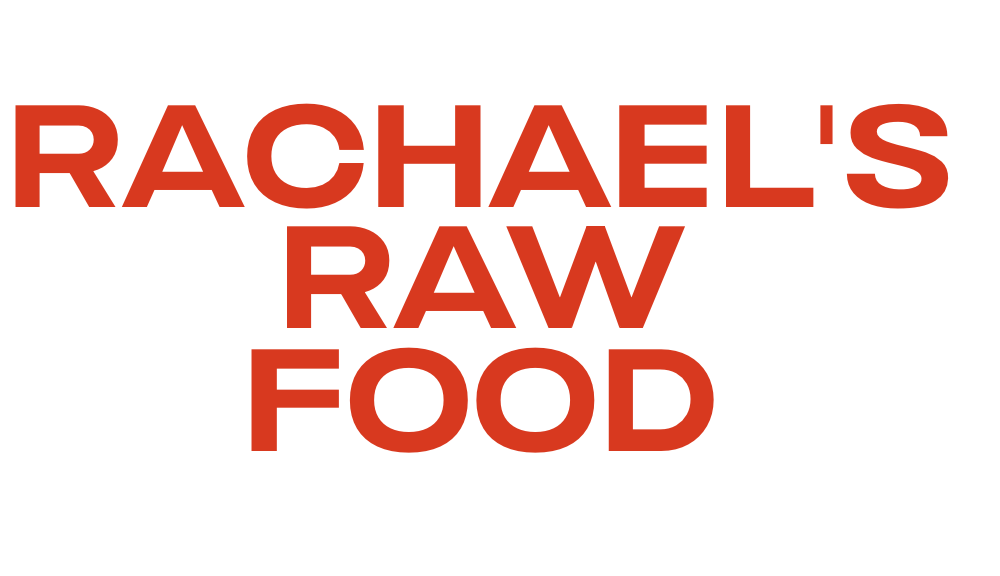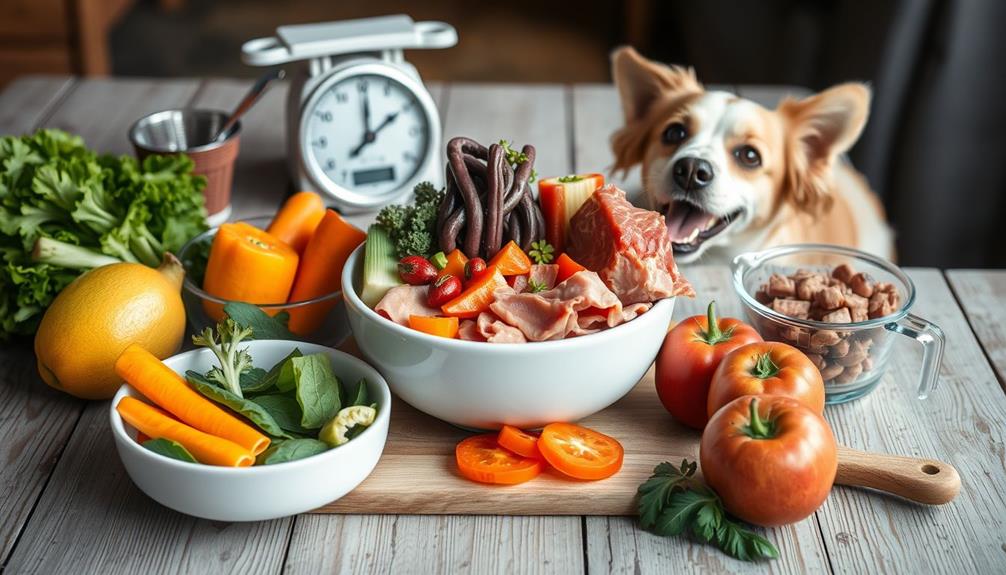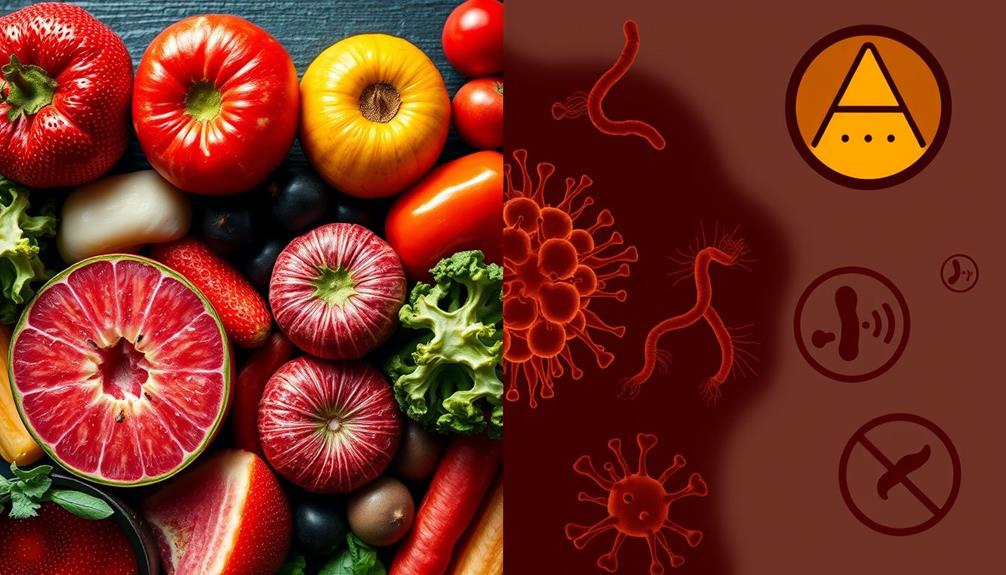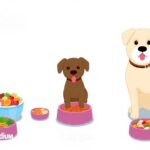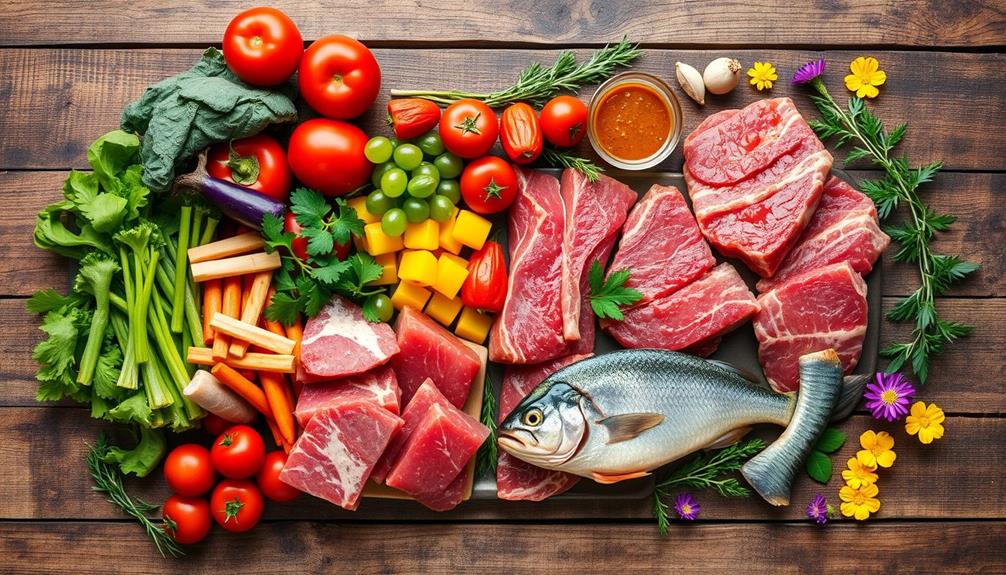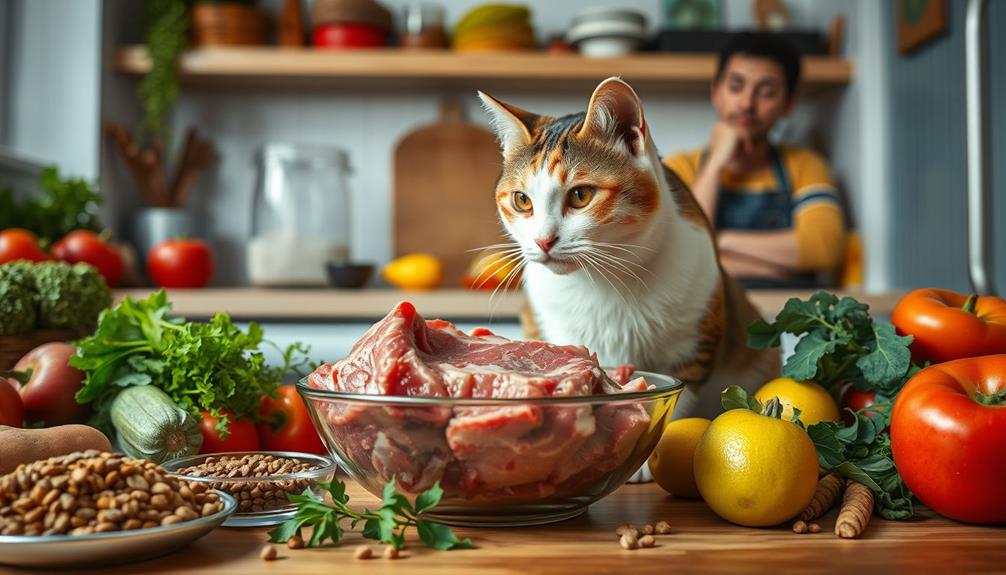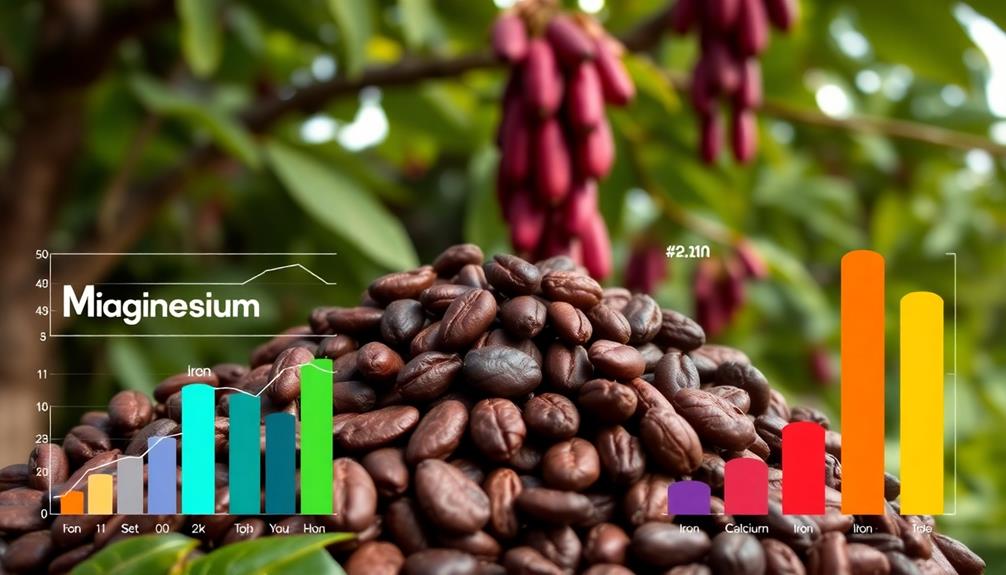Feeding your dog a raw diet is all about getting the portions right. You should give them about 2% to 3% of their body weight daily. For active dogs, aim closer to 3%, while less active dogs usually need about 2-2.5%. Smaller breeds under 5 pounds may require 5-6%. It's vital to adjust these amounts based on their activity level and monitor their weight regularly. If you're shifting to raw food, start gradually to avoid digestive issues. Keep an eye on your dog's health for the best results. You'll find more essential insights on shifting and meal options ahead.
Key Takeaways
- Feed adult dogs 2-3% of their ideal body weight daily, adjusting based on activity levels and specific health needs.
- Active dogs typically require around 3% of their body weight, while less active dogs need 2-2.5%.
- Smaller dogs under 5 lbs may need to consume 5-6% of their body weight for optimal health.
- Use a raw feeding calculator to determine precise portion sizes based on your dog's weight and activity level.
- Monitor weight and health closely during dietary transitions, adjusting food amounts as necessary for balance and digestion.
Benefits of Raw Diet
A raw diet can offer numerous benefits for your dog, making it worth considering if you're looking to improve their health. One of the most notable benefits of raw is enhanced nutrient absorption compared to traditional kibble. This means your dog can enjoy better overall health and vigor, as they get more nutrients from their food.
Additionally, incorporating fresh ingredients into their diet can mimic the natural feeding habits of animals, promoting a more instinctive approach to eating, which is essential for their overall well-being proper diet includes fresh fruits.
You might also notice a shinier coat and improved skin condition, which can help reduce allergies and skin issues. Many pet owners report that their dogs display increased energy levels and a greater sense of comfort after switching to a raw food diet.
Chewing on raw food can improve dental health too, resulting in cleaner teeth and fresher breath. Even if you only add 25% raw food to your dog's diet, you could still see significant benefits, including improved digestion and fewer allergy symptoms.
If you're aiming to boost your dog's well-being, exploring the benefits of a raw diet could be a game changer. It's a holistic approach that not only enhances their physical health but also enriches their overall quality of life.
Portion Guidelines
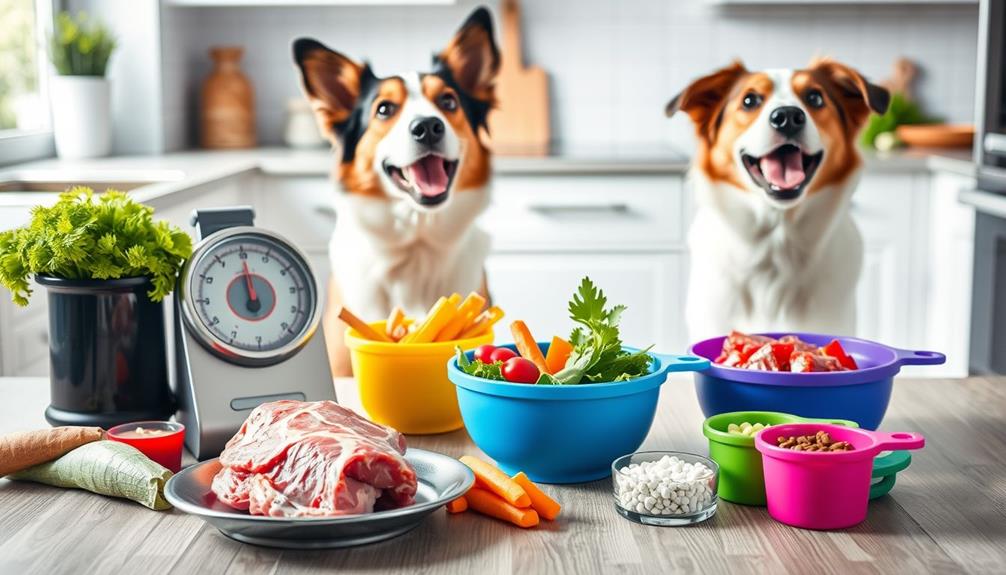
When it comes to portion guidelines for your dog's raw diet, you'll want to feed them about 2% to 3% of their body weight daily.
It's crucial to take into account your dog's overall health and any specific dietary needs they may have, as well as the impact of common types of cold medications on their well-being.
Keep in mind that more active dogs may need larger portions to meet their energy needs.
Regularly evaluating your dog's weight will help you make adjustments for their health and well-being.
Daily Feeding Amounts
Determining the right daily feeding amount for your dog on a raw diet is essential for their health and well-being. A good rule of thumb is to feed 2% to 3% of your dog's body weight in raw food daily. For instance, if your dog weighs 25 pounds, you should provide about 0.5 pounds (8 ounces) of raw food each day.
It's also important to take into account incorporating healthy dog snacks for added nutrition and enjoyment, as natural ingredients promote overall health and wellness.
Remember, smaller dogs often need a higher percentage of their body weight compared to larger breeds. For dogs weighing up to 5 pounds, you might take into account feeding 5-6% of their body weight, while those between 15-19 pounds typically require 2.5-3%.
Most adult dogs do well with two meals a day, though some owners opt for once daily feeding. Puppies, on the other hand, should be fed more frequently—about 3-4 times daily—to support their growth needs.
As you establish your dog's daily portion, keep a close eye on their weight and overall health. This way, you can make necessary adjustments to their food intake over time, ensuring they thrive on their raw diet.
Adjusting for Activity Levels
Adjusting your dog's food intake based on their activity levels is fundamental for maintaining their ideal health. Active dogs typically require a higher amount of raw food, around 3% of their ideal weight daily. In contrast, less active dogs usually need only 2-2.5%. For smaller breeds under 5 lbs, you'll need to feed them 5-6% of their body weight.
Additionally, it's significant to mention that monitoring your dog's hydration levels is critical, especially during dietary changes, as dehydration can impact their overall health and energy levels. For instance, juice diets may lead to nutrient deficiencies in humans, and while dogs have different needs, making sure they receive balanced nutrition is just as essential.
To effectively manage your dog's portion sizes, consider the following guidelines:
- Monitor Activity Level: Regularly assess your dog's energy expenditure to adjust their food intake accordingly.
- Split Meals: Divide the recommended daily amount into two meals, which helps mimic natural feeding behaviors and aids digestion.
- Use a Raw Feeding Calculator: This tool can help determine the appropriate amount of raw food based on your dog's weight and activity level, offering flexible guidelines rather than strict rules.
Always keep an eye on your dog's weight and adjust portions as needed. This way, you can guarantee your furry friend remains healthy and happy while receiving the right nutrients tailored to their lifestyle.
Starting a Raw Diet
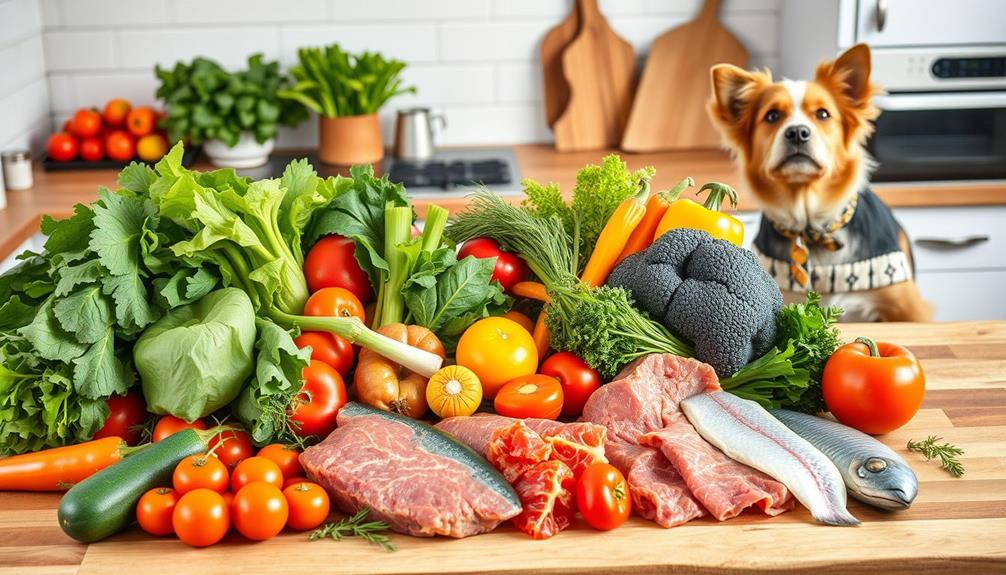
When you're ready to start your dog on a raw diet, begin the shift gradually by mixing 25% raw food with their current diet.
It's essential to guarantee your dog is receiving a balanced mix of nutrients, as the change can affect their overall health.
Monitor how your dog reacts during this process, as some might face digestive issues.
Adjust the proportions every few days until you reach a fully raw diet.
For additional insights on managing dietary changes, consider exploring support resources for caregivers that provide helpful guidance.
Transitioning Process Steps
Shifting your dog to a raw diet can be a rewarding journey, but it requires a careful approach. Start the change gradually over a week. Begin with a mix of 25% raw food and 75% of their current diet, then increase the raw portion daily.
Understanding your dog's nutritional needs is vital, as well as being aware of any potential dietary restrictions that may relate to their health, similar to how credit card terms influence personal finance management.
During this change, it's important to monitor your dog's weight and health. Here are some key points to keep in mind:
- Weight loss shouldn't exceed 1-2% of their body weight per week.
- If your dog shows signs of digestive issues, consider slowing down the change.
- Use a base mix of dehydrated vegetables or fruits to ease the process and enhance nutrition.
Always consult with your veterinarian for personalized guidance, especially if your dog has any existing health concerns or dietary restrictions.
They can help you determine the best feeding practices and guarantee your dog adjusts well. By taking these steps, you'll set your furry friend up for a successful change to a raw diet, promoting their health and happiness.
Monitoring Dog's Reaction
Monitoring your dog's reaction to a raw diet is essential for guaranteeing a smooth shift. As you start this new feeding regimen, keep a close eye on your dog's weight and overall health. It's vital to watch for any digestive issues like diarrhea or vomiting, as these signs may indicate that the change is too rapid or the food isn't suitable.
Additionally, just as with infants, environmental interactions and changes can impact a dog's adaptation to new dietary habits, so be observant of any shifts in their behavior or mood during this time. Emotional and psychological growth is also relevant in animals, and a well-balanced diet can contribute positively to their overall well-being.
Track your dog's energy levels and behavior; you're looking for signs that they're thriving on the raw diet compared to their previous kibble. Also, pay attention to improvements in their coat condition, skin health, and any allergy symptoms. These factors are common indicators of a successful change.
Consider keeping a feeding journal to document your dog's reaction and health changes. This record can help you identify patterns and make necessary adjustments to their diet as needed.
Quality of Ingredients

Quality matters when it comes to raw dog food ingredients. You want to verify that your dog's meals are packed with nutritional value, which directly ties back to the quality of the ingredients used.
Look for brands that prioritize transparency and quality control, like We Feed Raw, which include:
- Muscle meat and organ meat for essential nutrients
- Finely ground bone to provide calcium and phosphorus
- Locally sourced, hormone-free ingredients to promote ideal health
In addition, consider how these ingredients align with energy-efficient appliances that can help manage your household resources effectively.
A balanced diet for your dog includes a variety of these high-quality ingredients, tailored to their specific dietary needs based on their life stage.
Avoid raw dog food with fillers, artificial additives, or preservatives, as these can lead to allergies and other health issues.
Instead, choose options that offer a cleaner diet, verifying your furry friend gets the best nutrition possible.
Calculating Raw Food Portions
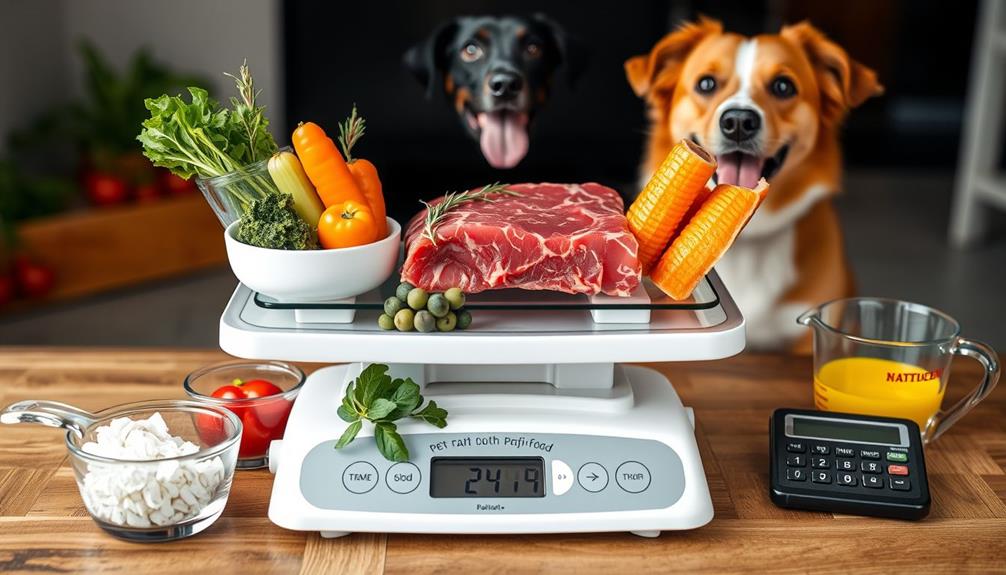
Determining the right portion of raw food for your dog is vital for their health and well-being. To calculate the appropriate amount of food, you should typically feed your dog 2-3% of their adult weight each day. Smaller dogs, weighing up to 5 lbs, require about 5-6% of their body weight, while larger breeds over 100 lbs usually need around 2-2.5%.
Additionally, making sure your dog receives a balanced diet with essential nutrients is important for their overall health, similar to how essential oils for toothache relief can aid in maintaining oral wellness.
For instance, if your dog weighs 25 lbs, you'd be looking at roughly 0.5 lbs (8 oz) of raw food daily, ideally split into two meals. Keep in mind that active or underweight dogs may need closer to 3% of their ideal body weight, while senior or overweight dogs might only require 1.5-2%.
Using a raw feeding calculator can help you determine precise portion sizes, but remember to observe your dog's condition closely. Adjustments may be necessary based on their activity level and health needs.
Feeding Recommendations for Puppies
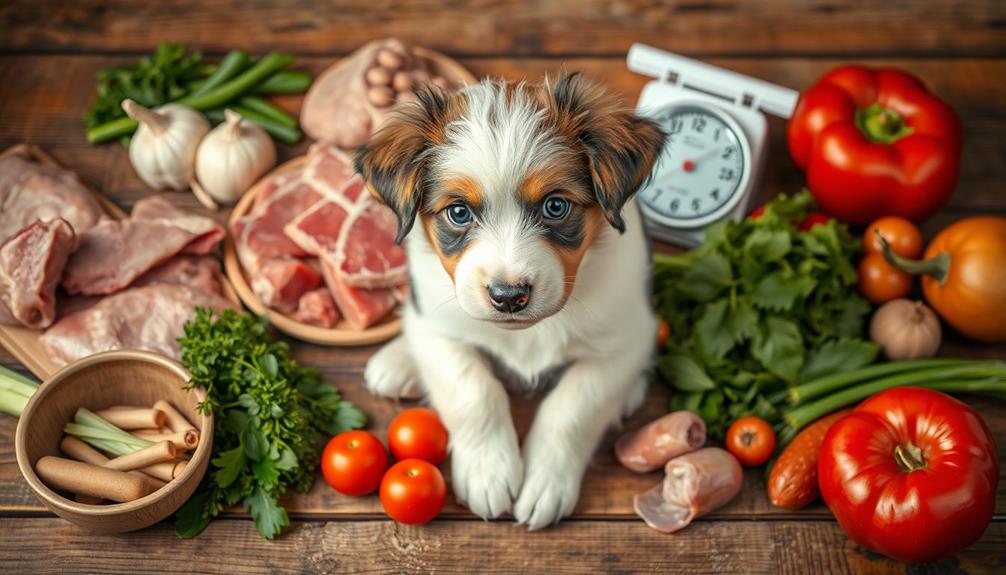
Feeding a puppy properly is essential for their growth and development. You should be feeding your puppy 2-3 meals per day, with each meal containing at least 5% of their current body weight in raw food. For a more tailored approach, consider calculating the portion size based on 2-3% of their ideal adult weight.
To support their development, selecting toys that promote fine motor skills and creativity can be beneficial, as they encourage active engagement and exploration best educational construction toys.
To guarantee a balanced diet, keep these recommendations in mind:
- Start with 1-2 recipes and gradually introduce variety as your puppy adjusts.
- Include helpful supplements such as fish oil, kefir, apple cider vinegar, and pre/probiotics to support their health.
- Monitor your puppy's growth closely and adjust food quantities as needed to promote healthy development.
Transitioning to Raw Diet
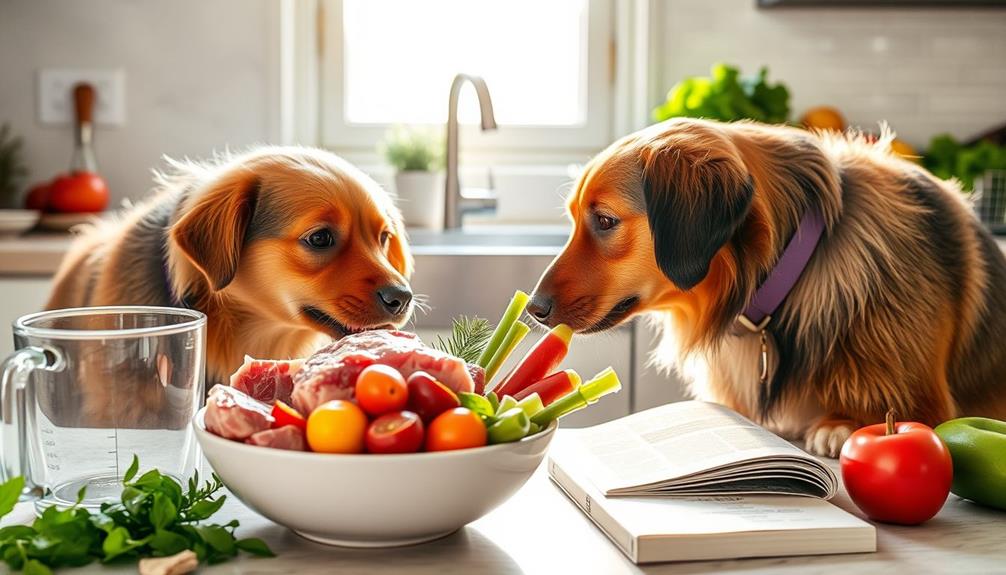
Shifting your dog to a raw diet can be a smooth process if approached thoughtfully. Start by mixing a small amount of raw food with your dog's current diet. This helps ease the shift and reduces the risk of digestive upset.
For healthy dogs, you can typically complete moving to a raw diet within a week by making gradual increases in raw food while decreasing kibble or other food types. However, if your dog has digestive issues, you might need to take a few weeks for a more gradual approach.
As you make these changes, it's essential to monitor your dog's response closely. Watch for any signs of discomfort or digestive upset, and adjust the pace of the shift if needed. If your dog seems to struggle, don't hesitate to slow down the process.
Consulting with a veterinarian during this change can provide you with personalized guidance tailored to your dog's specific needs. They'll guarantee that the raw diet you choose meets your dog's nutritional requirements effectively.
With careful planning and attention, moving to a raw diet can be a successful and beneficial change for your furry friend.
Choosing Nutritious Raw Food

When it comes to choosing nutritious raw food for your dog, quality matters more than quantity. Not all raw dog food is created equal, so you'll want to select brands known for their commitment to quality control. Investing in high-quality raw food can improve the health of your adult dog considerably.
To make sure your dog receives a balanced diet, keep these points in mind:
- Protein Variety: Include different protein sources and organ meats to boost nutritional value and prevent deficiencies.
- Reputable Sources: Choose brands like We Feed Raw that offer transparent sourcing practices; this guarantees high-quality ingredients without fillers or preservatives.
- Safety Assurance: Look for brands that implement strict quality control measures during production to ensure the food's safety and consistency.
Subscription Services for Raw Food

If you're looking for a hassle-free way to provide your dog with nutritious raw meals, subscription services can be a game-changer. These services deliver raw pet food right to your door, ensuring you have a regular supply without the stress of shopping.
You can easily customize your subscription plan to cater to your dog's specific dietary needs, making it a cost-effective solution that helps you save on overall pet food expenses.
Many subscription services offer prepackaged portions, so you won't have to measure out food daily. This feature simplifies the process of determining how much raw food to feed your puppy, ensuring you maintain a balanced diet that meets their nutritional needs.
Regular delivery schedules help you establish a consistent feeding routine, which is essential for your dog's health and well-being.
Additionally, many of these services provide access to expert resources and support, enhancing your experience as you navigate the world of raw feeding.
With the right subscription, you can feel confident that you're providing your dog with the high-quality raw meals they need to thrive.
Frequently Asked Questions
How Much Raw Food Should I Feed My Dog Chart?
To determine how much raw food to feed your dog, refer to a feeding chart that considers their weight and activity level. Adjust portions based on their health, ensuring they maintain a healthy weight.
How Much Raw Food Does My Dog Need a Day?
Think of your dog as a finely tuned engine. You'll need to fuel it with 2% to 3% of its ideal body weight daily. Monitor its activity and adjust portions for peak performance.
What Is the 80 10 10 Rule for Raw Dog Food?
The 80/10/10 rule for raw dog food means you should feed your dog 80% muscle meat, 10% organ meat, and 10% bone. This balance mimics a dog's natural diet and promotes overall health.
What Is the Best Raw Food Ratio for Dogs?
To determine the best raw food ratio for your dog, consider their ideal body weight and activity level. Generally, 2-3% is ideal for adults, while puppies need around 10% of their current weight.
Conclusion
Switching your dog to a raw diet might seem intimidating, but the benefits far outweigh the concerns. You might worry about balancing their nutrition, but with the right guidelines and quality ingredients, it's easier than you think. Remember, your dog's health and happiness are worth the effort. Embrace the journey, and soon you'll see how a raw diet can enhance their energy and well-being. Your furry friend deserves the best, and you've got the tools to provide it.
